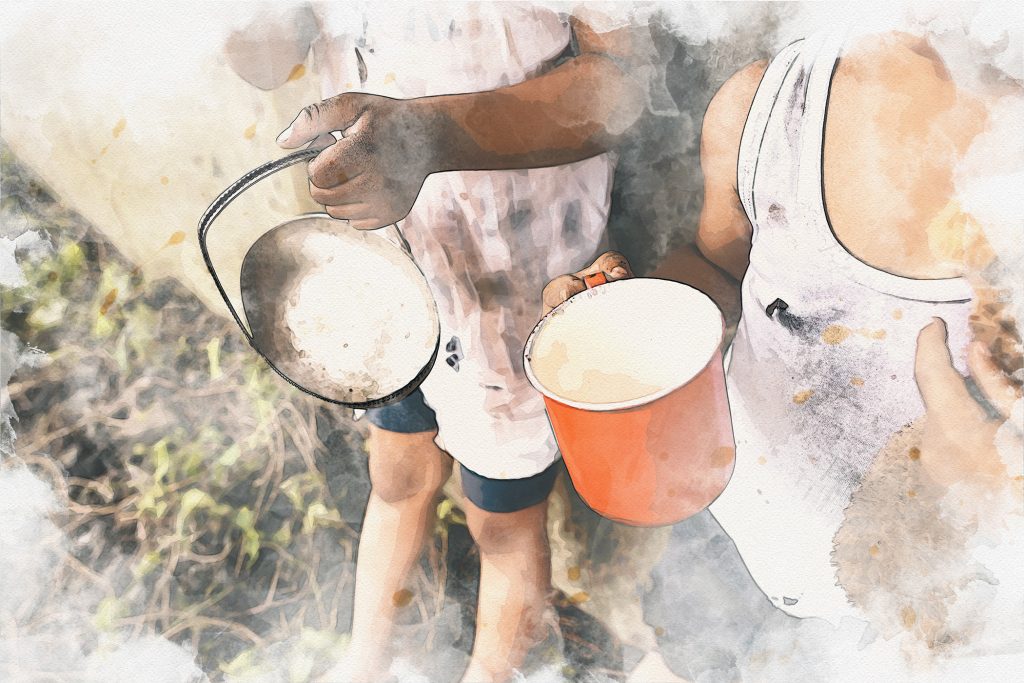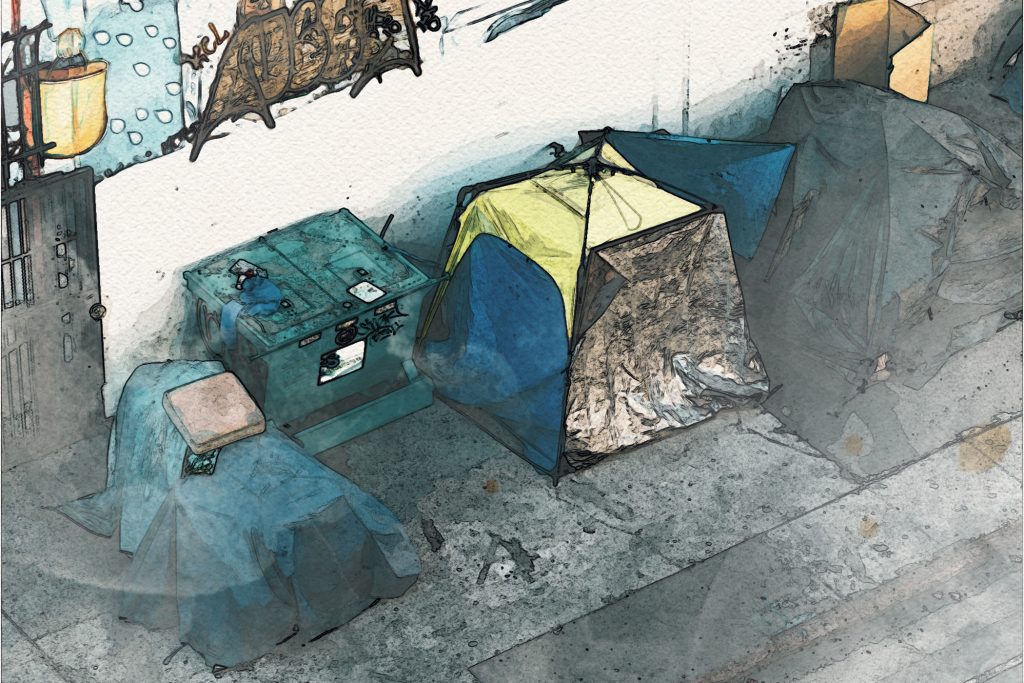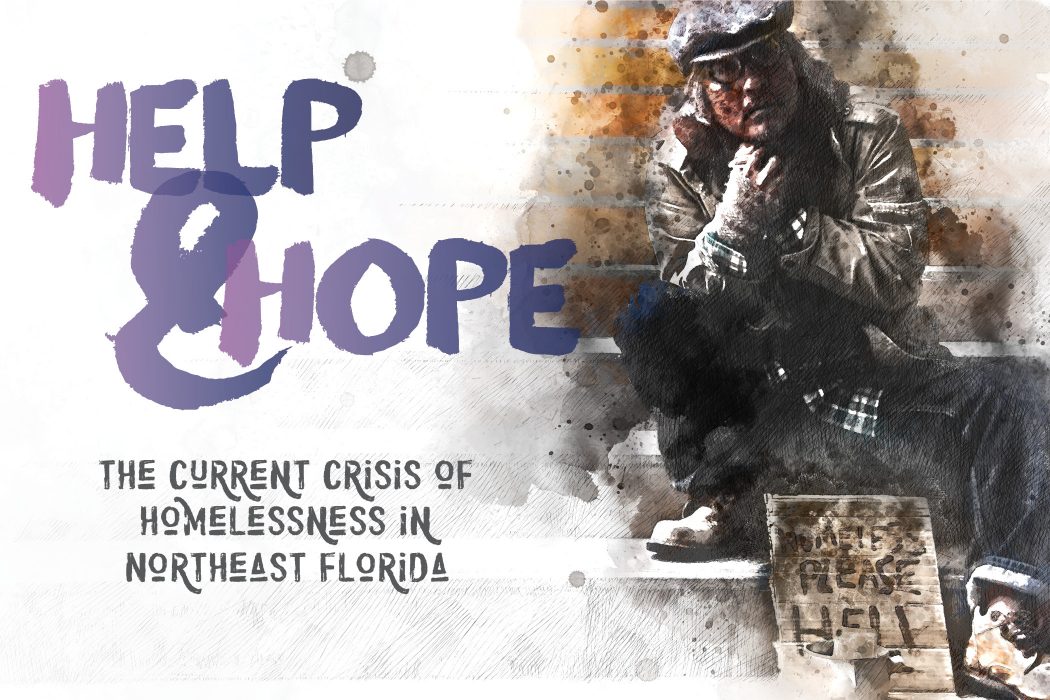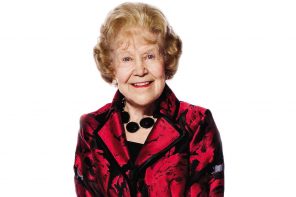There are 3,400 known persons throughout Duval, Clay and Nassau counties who currently are experiencing homelessness. Some are unsheltered, some are sheltered, but none has a permanent place to call home. That number is staggering, especially considering that these three counties — of all 67 in Florida — are ranked in the top 20 by highest incomes. How is it homelessness is an issue here?
The local homelessness crisis became more visible to residents during the pandemic when stay-at-home orders were put in effect. Many had no home at which to stay. They could not blend into society as easily as they had when folks were freely roaming about. During that time, large encampments known as tent cities sprung up around Jacksonville; one of the largest was downtown, which had to be dispersed due to health concerns.
How, in the prosperous city of Jacksonville, can there be both palatial mansions and tent cities, philanthropic generosity and welfare lines? The dichotomy is striking. And it is real.

WHAT IS HOMELESSNESS?
“It’s a complicated issue,” said Dawn Gilman, CEO of Changing Homelessness.
Homelessness is the description of a person’s housing situation, not a description of the person. The U.S. Department of Housing and Urban Development (HUD) defines homelessness in four categories: (1) people who lack a fixed, regular and adequate nighttime residence; (2) people at imminent risk who will lose their primary nighttime residence within 14 days and are not able to identify or afford a replacement; (3) people fleeing or attempting to flee domestic violence — this includes dating violence, sexual assault, stalking, or other dangerous or life-threatening conditions; and (4) people who qualify under other federal statutes. All of these groups are said to be experiencing homelessness.
TYPES OF HOMELESSNESS
Unsheltered homelessness refers to individuals or families living in places not meant for human habitation. They may be found in cars, tents, abandoned buildings, secluded forest areas, or underneath any outdoor structure that will shield them from the elements and help them feel somewhat secure. These are the conditions most people think of when they hear the word “homeless.” Males make up the bulk of this demographic in Jacksonville. More than half of the unsheltered homeless population is struggling with addiction as well.
Despite the stereotype, there is a vast population of people who are considered homeless because they lack permanent housing, but are temporarily living with others. They are considered part of the hidden homelessness issue. Because they are not accounted for in statistics on homelessness, they often go unnoticed. Rather than report their condition and rely on public resources, they turn to close friends, extended family and nearby neighbors for shelter. Though not sleeping on the street, they are still unable to meet the cost of housing and its related expenses. Most is this category tend to be younger in age. The first sign of homelessness for them may be “sofa surfing,” sleeping on others’ couches because they no longer have a bed of their own.
“Any day [they] could be told they have to leave, and then they’re out on the streets looking for shelter,” said Major Keath Biggers, Area Commander of The Salvation Army of Northeast Florida.
The most common type of homelessness is transitional homelessness, which usually lasts less than a year and comes as the result of a catastrophic event, such as a flood or fire; or a major life change, such as job loss, divorce, domestic abuse or a substance use disorder. Though some people experiencing transitional homelessness sleep in cars or similar outdoor spaces, others may enter a transitional housing program. Many are employed, but still are unable to afford both housing and other necessary living expenses.
People are said to be experiencing episodic homelessness if they are currently unhoused or have experienced at least three periods of homelessness within the past year. Like both hidden and transitional homelessness, many of those facing episodic homelessness are young, or dealing with a disabling condition like substance use disorder, mental illness or a physical health condition. Some episodically unhoused people have seasonal jobs or minimum wage employment, which doesn’t meet the cost of housing. Without intervention, resources and support, episodic homelessness is likely to become chronic.
If someone is experiencing chronic homelessness, it means they have been diagnosed with a disabling condition, and have been continuously without a home for more than a year, or for at least four episodes in the past three years. This population tends to be older and dealing with a complex, long-term, debilitating condition that restricts the ability to escape the homelessness cycle — a condition such as a physical disability, mental health issue or addiction. Many chronically homeless people live in places unsuitable and unsafe for daily living.
PANHANDLING
Just as it is important to understand that not all people experiencing homelessness are sleeping outside, it is equally important to note that not all people who are unhoused are panhandling — the majority do not.
“Panhandling and homelessness are two different things,” said Paul Stasi, LCSW, executive director of City Rescue Mission (CRM).
Panhandling is the practice of begging in the streets for money. According to Jacksonville’s city ordinance, it is illegal to solicit money on the side of the road without a permit. However, that ordinance is not easily enforced since there is controversy over the constitutionality of Florida’s varying panhandling laws as potentially violating First Amendment rights.
Regardless of details in legality, when it comes to panhandling, passersby are often caught in a quandary around whether or not to give. Questions arise if the words on cardboard signs are truth or ploy, because not all people who panhandle are experiencing homelessness. Instead, the giver and the receiver could be sabotaging each other, both caught in a cycle of toxic charity.
Toxic charity is one-way giving. Generous people who intend to help don’t realize the long-term harm they might be causing those to whom they give. For the giver, it be a way to remain distant and uninvolved, unfocused on the receiver’s underlying issue. For the panhandler, it can become a form of enabling, and a re-enforcement of helplessness and hopelessness. The dropping of a few dollars in the hat of a panhandler is transactional rather than relational, and that lack of human connection could very well be part of the base problem.
THE HOMELESS POPULATION
Focus Strategies is a company that uses analytics to provide communities with strategic, data-informed solutions to homelessness. In September 2021, they prepared a system-level disparities analysis on homelessness in Duval, Clay and Nassau counties. It found data to indicate that race, ethnicity and gender are important factors in predicting who enters the homelessness response system in Northeast Florida, who gains access to scarce housing resources once engaged, and the outcomes from interactions with the system.
The analysis found that Black or African American clients were overrepresented when compared to the general and poverty populations. They were more likely to exit homeless programs to permanent housing, but also more likely to return to homelessness after said exit. Hispanic clients, as well as females, were underrepresented in the homelessness response system when compared to the general and poverty populations. Females were also found less likely to return to homelessness after a permanent housing exit.
Singles
Currently, the majority of the local homeless population is made up of single adults. Of those, the elderly are increasingly becoming homeless, mainly due to medical issues, and they are the ones who remain homeless the longest.
Families

“We’ve been seeing a lot of family homelessness. That has been the most in-demand service we have been offering,” said Eileen Briggs, Chief Development Officer at Sulzbacher.
Families with young children, in most cases, have extended family members with homes who are willing to help them out before moving to the streets becomes imminent. Though not necessarily unsheltered, they still fall within homeless definitions.
Immigrants and Refugees
People leaving their countries of origin due to famine, war or politics often immigrate to America for refuge. Since the U.S. withdrawal from Afghanistan, Lutheran Social Services of Northeast Florida has resettled more than 270 Afghans. Some in this segment of the local homeless population arrive with a legal status other than refugee, and are therefore not eligible for federal assistance.
Transients

Over the years, Stasi has seen what he calls a transient, vagabond and nomad population who are experiencing homelessness by choice. They wander state-to-state, program-to-program, uninterested in establishing a long-term address. Sometimes, they take on odd jobs for cash to get by. While Stasi indicated that CRM helps these folks, he stressed that the organization’s intent is not to enable negative, unproductive and non-sustainable lifestyles.
“We are not just a handout, but a hand up,” he said.
CAUSES OF HOMELESSNESS
Countless causes of homelessness can be cited. The bottom line is that people have become homeless because, at some point in time, they became unable to pay for housing. Hard choices had to be made when monthly income wouldn’t cover taxes, housing, utilities, food, medical, transportation and other necessary expenses.
Inadequate Income
“Most people who are homeless are actually working. They just don’t make enough to afford an apartment and everything else you need to be able to live,” said Gilman.
There is an entire segment of society known as the working poor. These are employed individuals who still fall below the poverty line. Some may have minimum-wage positions ($11 per hour in Florida) while the average monthly rent for an apartment in Jacksonville is $1,530, according to RentCafe. This has resulted in a growing number of working people at risk of becoming homeless. Even for those earning well above the minimum wage, the number of households where living wages and working wages just don’t match is quickly increasing.
“When households can comfortably manage their housing costs and other necessities on a limited income, they are significantly less likely to experience homelessness,” said Shannon Nazworth, president and CEO of Ability Housing.
Lack of Education
Biggers said that a lack of education contributes greatly to the homelessness problem, and that The Salvation Army serves many who have never completed high school. But higher education is not a guarantee to ward off homelessness. Well-educated men and women can also find themselves in dire circumstances.
Domestic Violence
Even those who can financially afford a permanent residence are sometimes forced to flee from there. Natural disasters play a part, but family dynamics, especially domestic violence, may force individuals from their homes.
Substance Use Disorders
Substance use and abuse is a potential factor in almost every type of homelessness. Although downtown Jacksonville has numerous shelter programs, not all who need them use them. Much of the time, the reason is associated with substance use, which might cause impaired judgment in making safe choices, an unwillingness to follow the rules of the shelter, or violent outbursts while high.
Physical Health Issues
Physical health problems can lead to a financial crisis, resulting in homelessness. Unhealthy people who cannot go to work may lose their employer-provided healthcare benefits. Any person, employed or not, may be unable to afford healthcare premiums or extremely high medical bills.
“Roughly two-thirds of bankruptcies are due to extreme healthcare costs,” said Jennifer Ryan, MPH, CEO of Volunteers in Medicine Jacksonville.
Volunteers in Medicine helps those who are living paycheck to paycheck keep their jobs by helping them stay healthy. It reaches out into the community, providing free medical services for the ALICE® — Asset Limited, Income Constrained, Employed — population, a term coined and registered by United Way.
“I see us as an initiative to prevent homelessness,” said Ryan. “If we can keep them healthy and keep them working, most likely they will stay in their homes, keep their mode of transportation, and be able to provide for their families.”
Mental Health Issues
In 2020, Barbara Poppe and Associates, national experts on the functioning of the homeless service ecosystem, released a high-level, regional review of Jacksonville’s approach to homelessness. They found, on a January night in 2019, 508 people living outside, unsheltered, despite 20% of existing emergency shelter beds and transitional housing being empty on that same night. Often, this phenomenon is due to challenging mental health issues, which might render a person unable to access alternatives on their own and unable to maintain self-sufficiency beyond placement.
AFFORDABLE HOUSING AS A SOLUTION
“Housing is the most effective solution for addressing the universal, basic need for shelter. It is also a powerful tool to prevent families from experiencing homelessness in the first place,” said Nazworth.
Still, the market of affordable rentals and achievable paths to home ownership is becoming more and more slim.
Changing Homelessness administers a database for all community partners to share information about who they are serving and where they are conducting outreach. While the lack of affordable housing has been apparent for more than a decade prior, pandemic unemployment may have exacerbated the issue. In 2021, Changing Homelessness established a Housing Services team to connect local homeless services agencies with affordable rental units throughout the city. But the demand far exceeded the supply. By the last quarter of that year, more than 17 local agencies conducted an average of 680 searches each month against the only 158 properties actively listed in the system.
While those on the front lines of the crisis agree that the solution to homelessness is housing, it still takes capital to acquire and rehab dwelling space. For-profit developers and landlords cannot build or manage deeply affordable housing, which is generally defined as costing no more than 30% of a household’s income. They are also, understandably, reluctant to rent their properties to households with histories of eviction. Changing Homelessness’ 2021 annual report indicated that the expenses associated with the homelessness effort exceeded revenue.
To gain units for the vast pool of low-income population, subsidies are needed at the local, state and federal levels to provide the housing as well as the maintenance. Poppe’s 2020 report recommended establishing a Landlord Mitigation Fund to protect landlords who were willing to reduce screening criteria for potential renters. It would reimburse property owners —up to a certain amount — for any losses that might be incurred beyond the security deposit. But the looming question remains: Where would the funding for all of this come from?
Ability Housing is attempting to tackle this obstacle by providing affordable and attainable rental housing for individuals and families who earn less than the Area Median Income (AMI) and for whom market-rate housing is out of reach for their budget. Yet, they face the same challenges as other buyers in the real estate market, often competing with institutional investors who are willing to pay above asking price.
“For landowners or philanthropists looking for a way to make a difference, donating funds or property to Ability Housing is an effective way to ensure that your contribution will be used to create housing for families in need,” Nazworth said.
Gilman agreed.
“If we could get access to deeply affordable one-bedroom apartments or studios, that would help us resolve some of this chronic homeless issue,” she said.
A DEBATED APPROACH
Many agencies focusing on the homelessness crisis take the Housing First stance. This federal initiative prioritizes providing the basic necessities of food and permanent housing ahead of other less-critical issues like addiction recovery, employment security, health care, and life skills development. Housing First is based on the premise that food and housing serve as a platform from which people can improve their quality of life in other areas. Participation in support services is not a requirement to receive.
A similar program, known as Rapid Re-Housing, is aimed at individuals and families who are experiencing episodic or transitional homelessness. The goal is to get people out of shelters and into housing as fast as possible by providing short-term rental assistance. It, too, is offered without preconditions such as employment, income, sobriety or a clear criminal record.
Not all agree with the effectiveness of these approaches. Though there are lists of success stories, arguments against both programs claim they have not reduced overall rates of homelessness. If the underlying cause of the homelessness is not addressed, the cycle repeats.

BEYOND BRICK-AND-MORTAR
To end homelessness, housing is certainly needed. But it seems that’s not enough. Even when in permanent housing, many need ancillary services if that housing is to be sustainable. Further, there are human essentials that need attention in the interim. Most people unfamiliar with the crisis do not realize that benefits allotted by the Supplemental Nutrition Assistance Program (SNAP) do not include household items like laundry detergent, paper goods, cleaning supplies, feminine products and toiletries.
Many of Jacksonville’s homeless-serving organizations provide case managers and resources to aid in long-term independence and success. They offer hot meals, pantry food, essential clothing, hygiene items, counseling services, and access to other resources either directly or by referral to partner agencies. Sulzbacher’s HOPE Teams (Homeless Outreach Project Expansion) even brings medical and psychiatric services by van to those unable to come to the brick-and-mortar campuses.
During his 21 years with CRM, Stasi has observed an array of cases and categories when it comes to homelessness and its causes. He calls the people who want to work — but for a variety of reasons, cannot — “aspirers.” He gave the example of someone whose identification documents have been either lost or stolen.
“They can’t get a job because they don’t have ID. They can’t get into a shelter because some require ID,” Stasi said. Without documentation, such an aspirer would be hard-pressed to secure permanent housing.
CRM offers a low-barrier shelter with less stringent requirements, where no paperwork is required. It’s Overcomers Program provides casework assistance to help an individual go through the process of recovering identification to obtain employment as a start to establishing sustainable housing and self-sufficiency.
Like CRM, The Salvation Army has assisted people with restoring their documents of identification. Biggers has often seen cases where those eligible for veterans benefits or Social Security just didn’t know about them, or couldn’t secure them through their own efforts.
FUNDGIVING
Area providers of homeless assistance and related services find support from a wide range of public funds and private donations. Poppe’s estimates show that more than half of the funding comes from the private sector. Of public funding, nearly all of it comes through federal assistance. Only 1% is from the state and 3% from local government.
One type of federal funding is for the FL-510 Continuum of Care Program (CoC), a collaborative of over 40 nonprofit service providers working together to prevent and end homelessness throughout Duval, Clay and Nassau. Changing Homelessness has been designated as the lead agency by these local counties, the state of Florida, and HUD at the federal level. One of the agency’s tasks is to deliver a comprehensive response to homelessness, which includes coordinating the funding and delivery of services in this geographic area.
As the leader, Changing Homelessness applies for funding on all levels — federal, state, city and local foundations — for all categories within the homeless population. The two main sources of grant funding are from HUD and the VA. Still, funding falls short of being able to provide all the help needed for all who are in need of it. A coordinated intake process prioritizes those who need it most, those medically vulnerable and who have been without a home longest are first in line.
Rising rental prices are a major contributing factor to the backlog in the system. Even the rental subsidies of HUD and VA vouchers that Sulzbacher can provide are no longer enough help to cover rental costs, which makes it more difficult for those in emergency housing to transition into permanent housing.
But not all organizations rely on federal funding. Volunteers in Medicine receives their funding locally, including their grants. Of their donations, two-thirds are in-kind. Over 250 doctors, nurses, front desk staff, and recordkeepers volunteer each month. CRM gets no public funding, aside from one state-funded residential drug treatment prison diversion program. They rely on a variety of private and business donations to sustain their operations. Like many other nonprofits, CRM also operates a thrift store and other small businesses to provide income to the mission. And, of course, virtually all nonprofits host some sort of annual fundraiser. The Salvation Army has the Red Shield Ball; Sulzbacher has Transformations.
“Jacksonville is an incredibly compassionate community,” Briggs said. But, as a community, “we’re struggling to care for all these people that need our help.”
The Community Foundation for Northeast Florida is also quite active in making grants and investments to improve the quality of life for some of the Jacksonville region’s most vulnerable citizens. “We have a lot of grantmaking activity that goes to support homeless-serving organizations in the counties we serve,” said James Coggin, MBA, Senior Program Director. The Community Foundation has two segments of grantmaking: discretionary staff-advised funds, which recently made one to Changing Homelessness to help educate about affordable housing; and donor-advised funds, which drive a lot of investing into addressing the issue.
“We’re seeing a lot of great collaboration and a positive direction in combating this issue. That doesn’t mean we don’t still have a lot of work to do. There’s certainly a lot left that needs to be addressed. The housing shortage is very real,” he said.
Public-private partnerships are essential to mitigating the crisis. When investments are made in solutions to homelessness, that investing actually reduces the cost to a community in terms of fewer arrests, shorter jail stays and lower usage of crisis services.

SUCCESS IN THE VETERAN SECTOR
VA funding from the government has helped to allay what, a few years ago, had been the main concern around homelessness in the Jacksonville area: veterans.
Much of the reduction in homelessness among veterans can be attributed to Built for Zero, a national movement to end homelessness one population at a time. The program operates collaboratively so that no single agency or organization has to shoulder the burden alone. Led by the overarching Changing Homelessness, the focus initially had been on two key groups: veterans and people experiencing chronic homelessness. Locally, Sulzbacher has housing available specifically for veterans, as do some of the other service providers in town. If Sulzbacher identifies homeless veterans on the street, the organization is able to immediately get them into emergency housing, and then quickly into a permanent housing slot.
Increased investment in permanent housing for veterans further contributed to this improvement. The Poppe report showed a whopping 82% decrease in homelessness among veterans from 2009-2019, a sign that collaborative efforts were working.
TRENDING
Poppe’s report also cited great progress in Jacksonville between 2009 and 2019 with a significant drop in homelessness overall. It showed that Jacksonville outperformed the national average in its coordinated efforts to combat homelessness for all but one category: single adults living unsheltered. This category showed a local increase of 20%, while nationally, that population had decreased by 7%. The most significant local gaps were limited access to affordable housing, and support to maintain housing once established — especially for single, non-veteran adults. This population has now become a main concern, particularly single seniors with disabilities.
“From our by-name list, we have 191 folks who are out on the street who are 55-plus and are chronically homeless,” said Gilman. The most visible homeless population is in downtown Jacksonville, but this figure is over the three-county area.
The next wave could potentially be the single-mom families with young children who are in crisis situations now. Gilman has a concern for the number of households experiencing domestic violence. Families with children tend to double up when necessary, or even more than double, in order to afford housing. But this is not ideal and, sometimes, not safe.
“Because of the tight rental market, they are extremely reluctant to leave because there is nowhere for them to go,” she said.
Sulzbacher Village was designed to include key resources for this population. There’s a pediatric health center, an early learning center and an after-school program, but the Village already has quite a waiting list of families.
From a systemwide perspective, it is true that Northeast Florida has seen a drastic increase in the number of families requesting assistance, but only 12-15% of those living on the streets are households with minor children. This disparity is likely because families with young children usually have more support networks — family, friends, public programs — to help them before they take to the streets. This means that the overwhelming majority of those who live on local streets are still single adults.
“Right now, it is really tough for families, and we don’t want them to become homeless. But we already have a lot of people who are homeless already. We’re triaging. We don’t have enough for everybody, so who goes first?” said Gilman.
HELP AND HOPE
Jacksonville has a strong coalition of nonprofits focusing on homelessness and bringing solutions. Those institutions mentioned in this article are only some of the several reputable and noteworthy ones in the local area that need your help in addressing the broad scope that this issue encompasses. Make monetary donations to trustworthy organizations that provide assistance and resources, either directly or indirectly, that target the current crisis. Know what your dollars are doing.
In addition to your treasure, consider giving your time and talent, because a community thrives when its citizens do. Many volunteer opportunities had to be curtailed during the height of the pandemic, but most have re-opened now. If there are agencies you’ve worked with in the past because you believe in their mission and have a heart for the population they target, contact them again to find out what their current needs are in this changing landscape. Maybe you could volunteer as a food server at one of the many meal centers in town, or help distribute goods at a homeless camp. Ask what in-kind donations are being accepted. Perhaps you could provide move-in kits for those placed in rapid rehousing; these kits contain large and small items that SNAP benefits won’t help with, including much needed beds and linens. Do you have particular professional expertise that you could offer? You can make a difference.
There have been great strides made toward resolving the crisis of homelessness in Northeast Florida, but there is still much more to be done. What’s your part?
By Mary Wanser





